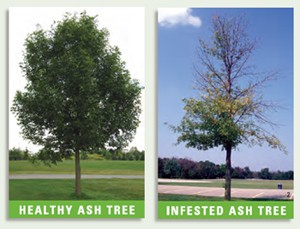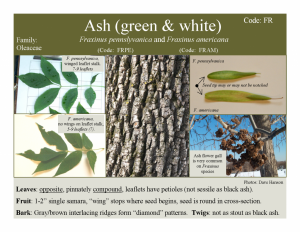A quarantine for Emerald Ash Borer (EAB), an invasive insect that destroys ash trees, has been expanded to include five more Tennessee counties.
With EAB discovered in traps in Franklin, Marshall, Rutherford, Trousdale and Williamson counties, those areas are now under restriction for the movement of ash trees and ash tree products. EAB was confirmed in Cumberland and Bledsoe counties in June. Tennessee now has 46 counties under state and federal EAB quarantine. EAB is a destructive forest pest that made its way from Asia to the United States in the 1990s. This pest was first detected in Tennessee in 2010. Typically, EAB can kill an ash tree within three years. The Tennessee Department of Agriculture and USDA-APHIS are working together to identify infestation using purple box traps placed in ash trees across the state.
The EAB quarantine prohibits the movement of firewood, ash nursery stock, ash timber and other material that can spread EAB. Citizens should report any symptomatic ash trees to the department of agriculture and follow these simple rules:
- Don’t transport firewood.
- Use firewood from local sources near where it will be burned.
- If you purchase firewood, make sure that is labeled and certified to be pest free.
- Watch for signs of infestation in your ash trees.
How Do I Know If My Ash Tree Is Infected?
Symptoms
 Crown dieback: Dieback of the upper and outer crown begins after multiple years of EAB larval feeding. Trees start to show dead branches throughout the canopy, beginning at the top. Larval feeding disrupts nutrient and water flow to the upper canopy, resulting in leaf loss. Leaves at the top of the tree may be thin and discolored. An example of this is shown below.
Crown dieback: Dieback of the upper and outer crown begins after multiple years of EAB larval feeding. Trees start to show dead branches throughout the canopy, beginning at the top. Larval feeding disrupts nutrient and water flow to the upper canopy, resulting in leaf loss. Leaves at the top of the tree may be thin and discolored. An example of this is shown below.
Epicormic Sprouting: When trees are stressed or sick, they will try to grow new branches and leaves wherever they still can. Trees may have new growth at the base of the tree and on the trunk, often just below where the larvae are feeding. An example of this is shown in the picture above, where small branches are growing on the trunk, about 6 feet off the ground.
Bark splits: Vertical splits in the bark are caused due to callus tissue that develops around larval galleries. Larval galleries can often be seen beneath bark splits.
Woodpecker feeding: Woodpeckers eat emerald ash borer larvae that are under the bark. This usually happens higher in the tree where the emerald ash borer prefers to attack first. If there are large numbers of larvae under the bark the woodpecker damage can make it look like strips of bark have been pulled off of the tree. This is called “flecking.” An example of this is shown below.
Signs
D-shaped emergence holes: As adults emerge from under the bark they create a D-shaped emergence hole that is about 1/8 inch in diameter. An example of this is shown below.
S-shaped larval galleries: As larvae feed under the bark they wind back and forth, creating galleries that are packed with frass (larva poop) and sawdust and follow a serpentine pattern. An example of this is shown below.
Larvae: Larvae are cream-colored, slightly flattened (dorso-ventrally) and have pincher-like appendages (urogomphi) at the end of their abdomen. By the time larvae are done growing they are 1 1/2 inches long. Larvae are found feeding beneath the bark.
Adults: Adult beetles are metallic green and about the size of one grain of cooked rice (3/8 – 1/2 inch long and 1/16 inch wide). Adults are flat on the back and rounded on their underside.
TDA’s Division of Forestry estimates that there are 261 million ash trees on public and private timberland in Tennessee, potentially valued as high as $9 billion. For more information about EAB and other destructive forest pests, as well as tips for infestation prevention, visit Protect TN Forests. – See more at: http://tn.gov/agriculture/news/16537#sthash.Va2h5OZG.dpuf
More News Here


















